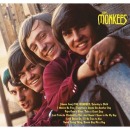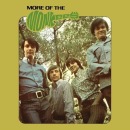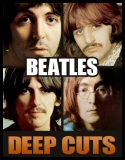Music Home / Entertainment Channel / Bullz-Eye Home
 Buy your copy from Amazon.com
Buy your copy from Amazon.com
| The Monkees: The Monkees Released: 2006 |
 Buy your copy from Amazon.com
Buy your copy from Amazon.com
| The Monkees: More of the Monkees Released: 2006 |
Oh, sure, they’re too busy singing to put anybody down…but God knows the reverse has never been true.
Folks love an easy target, and, on the surface, the Monkees would seem to be one of the easiest; after all, they didn’t even exist until some folks at NBC, in an attempt to swipe a little bit of the Beatles’ success for themselves, decided to put together a TV show about a band. Voila! Instant lack of credibility! From there, however, many of the great unwashed tend to start throwing out comments like, “And they didn’t even write their own songs or play their own instruments!” And that’s just not true…well, not entirely, anyway.
In celebration of the Monkees’ 40th anniversary, Rhino Records has begun a substantial reissue program of the group’s albums, starting things off with their self-titled debut and their sophomore effort, More of the Monkees. This certainly isn’t the first time the Monkees albums have been released on CD…Hell, this isn’t even the first time Rhino’s put them out with bonus tracks!…but, this time around, they’re really going all out. Each album is now a 2-disc set; Disc 1 contains the original stereo album, Disc 2 has the mono album, and each disc tacks on anywhere from eight to ten bonus tracks which range from rarities and alternate takes to alternate mixes and even a jingle for Kellogg’s cereal! There are also considerably in-depth liner notes and studio credits, the latter confirming conclusively that, yes, the Monkees did play on their albums…if not necessarily as the lead performers.
The Monkees kicks off, appropriately enough, with the group’s theme song, setting the stage for an album’s worth of poppy goodness. The track was written by the duo most associated with the Monkees’ songwriting: Tommy Boyce and Bobby Hart. Boyce and Hart wrote six out of the album’s dozen tracks, including the #1 hit, “Last Train to Clarksville.” It’s notable that, for as much of a touchstone of ‘60s pop as this album has come to be recognized, “Clarksville” – backed with “Take a Giant Step” – was the only single to be released from it. Certainly, half the songs could’ve been hits if given the chance, particularly “Saturday’s Child” (written by David Gates, later of Bread), “Let’s Dance On,” and “I Wanna Be Free” (the latter two both Boyce & Hart compositions); “Gonna Buy Me a Dog,” however, remains just as dumb now as it was four decades ago. Of the bonus tracks, the best of them – “All the King’s Horses,” “So Goes Love,” and “(I Prithee) Do Not Ask for Love” – have been issued before, generally on the group’s Missing Links rarities collections; of the new stuff, the best is Mike Nesmith’s demo of “Propinquity (I’ve Just Begun To Care).”
More of the Monkees has been dismissed by many over the years because it was put together so rapidly, in order to capitalize on the group’s growing success, but, in truth, it holds up better than its predecessor. The Monkees’ version of “(I’m Not Your) Steppin’ Stone” inspired the Sex Pistols, just as “Mary Mary” caught the ear of Run-DMC; in addition, there’s another #1 hit to be found, that being “I’m A Believer.” “She” and “Look Out (Here Comes Tomorrow)” are also among the album’s classics, and, believe it or not, even the Peter Tork-sung “Your Auntie Grizelda” grows on you if you listen to it enough times. Bonus tracks here include “Apples, Peaches, Bananas, and Pears,” early demos of “Through the Looking Glass,” “Words,” and “I’ll Be Back Up on My Feet,” and a funny version of “Look Out (Here Comes Tomorrow)” which features narration by Tork to explain the purpose of the instrumental break.
The band’s next album, Headquarters, would find them making a major statement by writing and performing all of the material themselves (or, at least, taking lead on all the instruments), but even though these two albums are the ones where Dolenz, Jones, Nesmith, and Tork had the least amount of input, they’re still solid representations of commercial pop during the ‘60s…and, by God, the hooks still hold up even 40 years later.
wharris@bullz-eye.com






